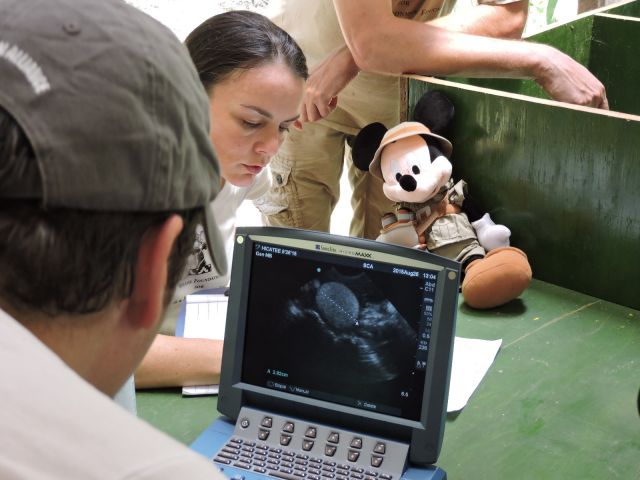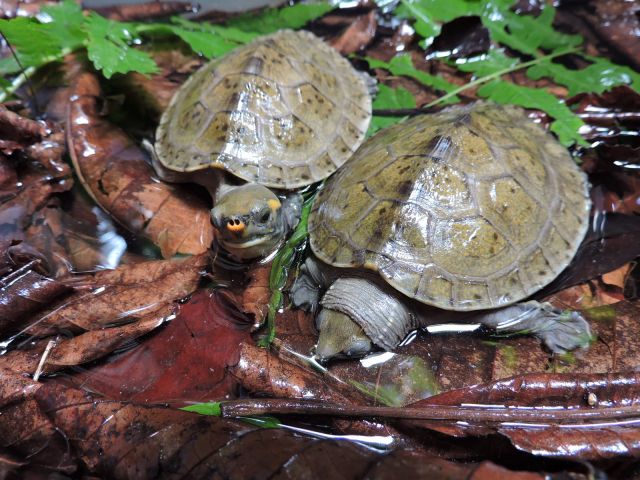Surprises—and Successes—for the Hicatee Breeding Program in Belize
by Howard Goldstein 


Ranked among the list of the Top 25 Most Endangered chelonian species in the world, the Central American river turtle—also known as the Hicatee—is threatened throughout its range by over-harvest in the wild as a food source. The TSA believes that any species ranked critically endangered (IUCN Red List) should have a captive population, either in or ex situ. Unfortunately the Hicatee has an abysmal record of captive propagation due to an unusual egg development cycle and poorly known nesting habits, hence breeding and management techniques have not been standardized.
In response to the need to establish protocols for sustained and successful captive breeding, the Hicatee Conservation and Research Center (HCRC), a collaborative program of the TSA and the Belize Foundation for Research and Environmental Education (BFREE), was completed on the BFREE reserve in southern Belize in 2014.
A few months after the groundbreaking success of seven Central American river turtles hatching at the HCRC in June 2015, TSA President Rick Hudson and Dr. Shane Boylan of the South Carolina Aquarium joined BFREE President Jacob Marlin, project manager Tom Pop, the rest of the BFREE crew, and University of Florida PhD student Nichole Bishop at the facility to conduct a reproductive assessment of the 22 animals constituting the current founder population.
That founder population was acquired in March 2014, and at the time, was believed to consist of three males and 19 females. Fully mature male hicatee are marked by triangular yellow coloration from the snout to the back of the head and longer, broader tails than females; based on the relative size and lack of secondary sex characteristics in the sub-adult animals, it was reasonable to assume that they were female... until Bishop calculated carapace length at the onset of maturity in D. mawii at 33.6 cm, a length that many of the captives were only now reaching. Bishop also performed a regression analysis with the morphometric data from HCRC turtles, with results indicating that most of the sub-adults were actually male. Ultrasound performed by Dr. Boylan and manual investigation by the team proved Bishop's predictions correct: the HCRC actually has two confirmed females and 15 confirmed males, consisting of three mature adults and 12 sub-adults. The remaining 5 animals are still too small to determine sex.
In addition to this discovery's ramifications for the breeding colony, it means something that almost all of the 25 randomly collected original wild-caught turtles are males. If this actually reflects sex ratios for wild D. mawii in the Belize and Sibun rivers then something is very wrong, but far more likely is that it represents some type of sampling bias. Given how little is known about D. mawii ecology, it is not at all unlikely that currently unknown differences between male and female temporal, spatial, or behavioral ecology account for the original sampling methods to have heavily favored male capture.
Although these sex ratios will require that new females are brought in to secure an adequate founder population for the HCRC, overall, this year's results have been excellent. Since the original 22 animals were transferred to HCRC in April 2014, all are healthy and thriving. Moreover, the mission to create a viable captive breeding program for D. mawii has been almost immediately successful, with the seven babies hatched at HCRC in June representing some of the handful of hicatee ever hatched in captivity. The seven animals are growing rapidly and in great condition. Even more important may be the fact that the female which laid those eggs last December has been confirmed by ultrasound to be gravid once again and very near to laying. The second confirmed female is nearly at reproductive size.
The facility has been extremely successful in both propagating native food plants on site and sustainably collecting others from the wild. Feeding trials have helped the HCRC determined the hicatee's preferred food items, and the most important, native Paspalum grass, has been cultivated in abundance around the breeding ponds and elsewhere on BFREE grounds. A great deal is also being learned from the colony about hicatee reproductive ecology, energy dynamics, hatchling morphology and captive care, and the necessary size minimum for non-invasive sexing of individuals.
In addition to establishing a breeding population, TSA has been part of a coalition of international and Belizean organizations dedicated to protecting the hicatee in the wild through increased national awareness. The continuing campaign of media and social programs is garnering considerable and growing success as the problem of over-harvest has begun to seep into the collective social conscious. While the problem remains and conservationists remain on high alert, reports from the field may indicate a decrease in hicatee meat sales and traffic since the onset of the program.
The need for more females will be addressed as soon as possible, but HCRC is eagerly awaiting our second nest and all indications predict continuing success in establishing a viable captive population and breeding protocols for this historically problematic species.
The TSA gratefully acknowledges the Disney Conservation Fund and the AZA Conservation Grant Fund for financial support during the first year of intensive research into the reproductive biology of this species.
